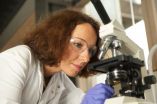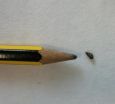(Press-News.org) A compound found in green tea could be a weapon in treatments for tackling cancer, according to newly-published research at the University of Strathclyde in Glasgow, Scotland.
The extract, known as epigallocatechin gallate, has been known to have preventative anti-cancer properties but fails to reach tumours when delivered by conventional intravenous administration.
However, in initial laboratory tests at the Universities of Strathclyde and Glasgow, researchers used an approach which allowed the treatment to be delivered specifically to the tumours after intravenous administration. Nearly two-thirds of the tumours it was delivered to either shrank or disappeared within one month and the treatment displayed no side effects to normal tissues.
The tests are thought to be the first time that this type of treatment has made cancerous tumours shrink or vanish.
In the tests, on two different types of skin cancer, 40% of both types of tumour vanished, while 30% of one and 20% of another shrank. A further 10% of one of the types were stabilised.
The researchers encapsulated the green tea extract in vesicles that also carried transferrin, a plasma protein which transports iron through the blood. Receptors for transferrin are found in large amounts in many cancers.
Dr Christine Dufès, a senior lecturer at the Strathclyde Institute of Pharmacy and Biomedical Sciences, led the research. She said: "These are very encouraging results which we hope could pave the way for new and effective cancer treatments.
"When we used our method, the green tea extract reduced the size of many of the tumours every day, in some cases removing them altogether. By contrast, the extract had no effect at all when it was delivered by other means, as every one of these tumours continued to grow.
"This research could open doors to new treatments for what is still one of the biggest killer diseases in many countries."
The research paper has been published in the journal Nanomedicine. Imaging equipment used in the research was funded by a grant from the Wellcome Trust.
INFORMATION:
The research links to Advanced Science and Technology, one of the research themes at Strathclyde's Technology and Innovation Centre, a world-class facility uniting academic and industrial partners in seeking innovative research solutions, job creation and business development.
Green tea compound shows promise for tackling cancer
2012-08-22
ELSE PRESS RELEASES FROM THIS DATE:
Glass offers improved means of storing UK's nuclear waste
2012-08-22
ILW makes up more than three quarters of the volume of material destined for geological disposal in the UK. (1)
Currently the UK's preferred method is to encapsulate ILW in specially formulated cement. The waste is mixed with cement and sealed in steel drums, in preparation for disposal deep underground.
Two studies, published in the latest issues of The Journal of Nuclear Materials and European Journal of Glass Science and Technology A show that turning this kind of waste into glass, a process called vitrification, could be a better method for its long-term storage, ...
Losing stream in our battle to predict and prevent invasive species
2012-08-22
Invasive species – plants, animals, and microbes introduced to regions beyond their native range – carry a global price tag of $1.4 trillion dollars. They are responsible for the loss of natural resources and biodiversity, damages to infrastructure, and an uptick in infectious diseases.
Not all non-native species pose a threat. Scientists around the world have spent the last several decades teasing apart the conditions that set the stage for debilitating invaders, like giant hogweed, zebra mussels, or gray squirrels. A number of hypotheses have emerged to help predict ...
Survival without water: A key trait of an aquatic invader to spread
2012-08-22
Nowadays, an increasing number of rivers and lakes are being invaded by exotic snails, which come from remote regions, and even other continents. Such species represent a threat to native species, as they compete for food or space with them.
This is the case of the mudsnail Potamopyrgus antipodarum. This small aquatic snail is native to New Zealand, and has spread throughout rivers, lakes or streams in Europe, Australia, America and Asia. The invasion success of this mudsnail may be partly due to the ability of females to reproduce without participation of males (i.e. ...
Scientists quantify nanofiber health risk to workers
2012-08-22
Health risks posed to people who work with tiny fibres used in manufacturing industries could be reduced, thanks to new research.
Research into the health risks posed by nanofibres – used to strengthen objects from tennis rackets to airplane wings – has pinpointed the lengths at which these fibres are harmful to the lungs.
Nanofibres, which can be made from a range of materials including carbon, are about 1,000 times smaller than the width of a human hair and can reach the lung cavity when inhaled.
This may lead to a cancer known as mesothelioma, which is known to ...
Thinking about kids? Man, you gotta shed the kilos
2012-08-22
Australian scientists studying the impact obesity has on pregnancy, are urging men to get 'match fit' before conceiving to assist with fetal development.
Reproductive experts from the University of Melbourne's Department of Zoology have discovered that a father's obesity negatively impacts sperm, resulting in smaller fetuses, poor pregnancy success and reduced placental development.
While the health risks surrounding obesity and pregnancy have largely been centred on overweight mothers, scientists from the University of Melbourne are putting the onus on men to shape ...
How to act if there is a fire on the AVE
2012-08-22
Researchers at the University of Cantabria have used computer models to analyse the best way to evacuate the Spanish High Speed Train, AVE, in the case of fire. The involvement of the crew in organising the fast transfer of passengers, completing the process before the train comes to a halt and collective collaboration to assist those with reduced mobility are just some of the strategies to be followed.
"In the event of fire on an AVE, two stages should be defined: the first is pre-evacuation in which passengers are transferred from one coach to another while the train ...
Male mice exposed to chronic social stress have anxious female offspring
2012-08-22
BOSTON (August 22, 2012) —A study in mice conducted by researchers at Tufts University School of Medicine (TUSM) suggests that a woman's risk of anxiety and dysfunctional social behavior may depend on the experiences of her parents, particularly fathers, when they were young. The study, published online in Biological Psychiatry, suggests that stress caused by chronic social instability during youth contributes to epigenetic changes in sperm cells that can lead to psychiatric disorders in female offspring across multiple generations.
"The long-term effects of stress can ...
MR enterography is option for pediatric patients with Crohn disease
2012-08-22
Parents with children nine years old and older who have Crohn disease should ask their children's doctor about MR enterography as a replacement for small bowel x-rays or CT enterography, a new study indicates.
Children with inflammatory bowel disease must often undergo repeated examinations, which, with x-rays and CT, could lead to significant radiation exposure, said William A. Faubion, Jr., MD, one of the authors of the study.
"MR enterography does not require any radiation, however the patient does have to drink an oral contrast agent, must hold their breath at times ...
Johns Hopkins researchers return blood cells to stem cell state
2012-08-22
Johns Hopkins scientists have developed a reliable method to turn the clock back on blood cells, restoring them to a primitive stem cell state from which they can then develop into any other type of cell in the body.
The work, described in the Aug. 8 issue of the journal Public Library of Science (PLoS), is "Chapter Two" in an ongoing effort to efficiently and consistently convert adult blood cells into stem cells that are highly qualified for clinical and research use in place of human embryonic stem cells, says Elias Zambidis, M.D., Ph.D., assistant professor of oncology ...
Typical IBD patients not represented in research studies
2012-08-22
Major randomized controlled trials of new therapies for inflammatory bowel disease (IBD) are conducted on patients who are not typical of those who physicians see in day-to-day practice, according to a new study in Clinical Gastroenterology and Hepatology, the official clinical practice journal of the American Gastroenterological Association (AGA).
The two major, often debilitating, illnesses that are recognized as IBD are ulcerative colitis and Crohn's disease. The introduction of biologics — the most prescribed medications for IBD patients — have dramatically impacted ...



